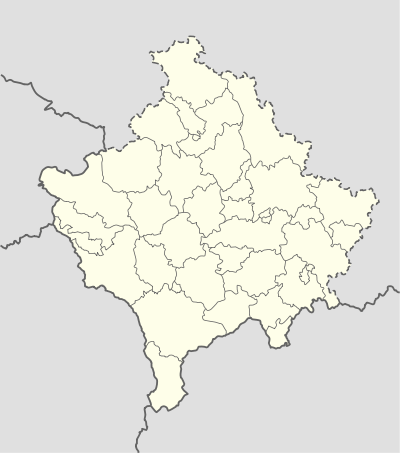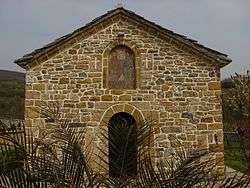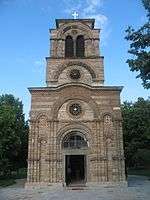Zočište Monastery
|
View of the reconstructed monastery church | |
 Location within Kosovo | |
| Monastery information | |
|---|---|
| Order | Serbian Orthodox |
| Established | Early 14th century |
| Disestablished | 1999 |
| Dedicated to | Saints Cosmas and Damian |
| Diocese | Eparchy of Raška and Prizren |
| Site | |
| Location | Zočište, Kosovo[a] |
| Coordinates | 42°22′31″N 20°42′8″E / 42.37528°N 20.70222°E |
Zočište Monastery (Serbian: Манастир Зочиште, Albanian: Manastiri i Zoçishtës) or formally St. Cosmas and Damian's Monastery (Serbian: Манастир Св. Козме и Дамјана) is a Serbian Orthodox monastery belonging to the Eparchy of Raška and Prizren, situated in the village of Zočište, about 3 miles (5 km) southeast of Orahovac, Kosovo.[a][1] The church originally of the 13th century, inferred as dedicated to St Nicholas has tombstones of 15th and 16th centuries. It was remodelled in the 16th century and again in 2008 after being ruined in 1999.[2]
The monastery was brought under the list of "Classification of Special Protective Zones" under the title “Zočište Monastery, Zoqishtë/ Zočište , Rahovec/Orahovac” by Law Nr. 03/L-039 dated 20 February 2008.[3]
The Church building has been rebuilt on the existing and consolidated foundations using original building material from the ruins of the old church.[2]
The monastery is famous for the relics of the Saints Cosmas and Damian. The shrine at the monastery was said to provide a miraculous cure for eye diseases and mental and psychosomatic disorders.[1] It is said to be "One of the most important cultural places for Serbian and Christian settlements in the Metohija region."[2] It was designated as Cultural Heritage of Serbia in 1954.[4]
History
The earliest reference to this monastery is as an endowment of a Feudal lord of the Medieval period though not established by confirmatory evidence. However, it was first mentioned in 1327 during the Stefan Dečanski period.[5] It was damaged during the Battle of Kosovo in 1389.[6] It was visited by Albanian Muslims who used the stones of the original building to construct a mosque in Prizren.[7] It was rebuilt in the late 16th century following the reinstatement of Serbian Patriarchate of Peć.[5] In the late 17th century, it was mentioned by Nikola Bošković, a merchant from Dubrovnik.[6]
Destruction
On 21 July 1998 the monastery was taken by the Kosovo Liberation Army.[1] The Albanians claimed the monastery to have originally belonged to the Albanian Orthodox Church and seven monks, a nun and several dozens Serbs sheltering there were taken hostage, although later released.[1]

The monastery was destroyed by the KLA during the Kosovan War on September 13/14, 1999, looting and then torching it.[8][9] The relics of Saints Cosma and Damian were transferred to Sopoćani Monastery, and main monastery bell was thrown in the well.[10]
Reconstruction
In October 2004, monastery reconstruction started, as Zočište was important and historical cultural designation. Old stones and fragments of the destroyed church were used in reconstruction, and monastery is almost identical as it once was.[11][12] In 2005, KFOR stopped reconstruction, with argument that local population opposes the restoration. When the ban was lifted, construction continued with the reconstruction of dormitories and main church building.[10] On November 13, 2007 a bus carrying about 30 students was stoned outside the monastery.[13]
Description
The church, amidst the old Serbian graveyard, built over rectangular layout with three exterior faces, comprised a single nave, linear barrel vault, with an eastern apse in semicircular shape both in the interior and exterior facade. The material used for construction consisted of dressed stones, lime mortar for binding and stone-slate roofing. The church had two niches of prothesis and diaconicon, on the eastern wall next to an altar table. As the church when remodelled functioned as funerary chapel it had a table to keep a coffin and seats for people attending the funeral.[2][5]
Tell tale remains were seen in the vault and in a niche above the western entrance to the narthex; these were in the form of decorated frescos of a frieze of prophets and of the patrons SS Cosmas and Damian. When the church was destroyed in 1999, icons and liturgical vessels were retrieved and deposited in Velika Hoča for safe keeping.[2][5]
The statues and figures seen in the church consisted of: St Nicholas, St Paraskeva and two Holy Warriors and fragment of the fresco of one of the officiating archbishops, on the southern wall; the figures of St Sava and St Simeon Nemanja on the west wall; the north wall had depiction of "The Vision of St Peter of Alexandria"; the east wall had the figure of the Archangel Gabriel from the Annunciation; and a niche in the prothesis had the figure of an archdeacon.[2]
External links
- Official website
- Манастир Зочиште и црква Св. Врача Бесребреника Кузман и Дамјана, with images of the monastery before and after destruction. (Serbian)
- Reportage about Zočište, with images of destroyed monastery and reconstruction
- Video of the Zočište Monastery
References
- 1 2 3 4 Duijzings, Gerlachlus (2000). Religion and the politics of identity in Kosovo. C. Hurst. p. 72. ISBN 978-1-85065-392-9. Retrieved 18 April 2011.
- 1 2 3 4 5 6 "Kosovo:Prioritized Intervention List" (pdf). pp. 77–78. Retrieved Regional Programme for and Natural Heritage in South East Europe. Check date values in:
|access-date=(help) - ↑ "On Special Protective Zones: Republic of Kosovo". Scribd.com. Retrieved 20 April 2011.
- ↑ Monuments of Culture in Serbia: Манастир са црквом Светих врача Кузмана и Дамјана (SANU) (Serbian) (English)
- 1 2 3 4 "Monastery of Holy Doctors Cosmas and Damian". mnemosyne.org. Retrieved 20 April 2011.
- 1 2 Алексей Лидов (2007). Косово: православное наследие и современная катастрофа. Индрик. p. 343. ISBN 978-5-85759-394-3. Retrieved 18 April 2011.
- ↑ Chronicles. Rockford Institute. 2003. Retrieved 18 April 2011.
- ↑ "SS. Cosmas and Damian Monastery". Retrieved 18 April 2011.
- ↑ "Research Report" (PDF). CSS Project. Retrieved 18 April 2011.
- 1 2 "Manastir Zočište kod Orahovca bez struje". RTS. Retrieved 21 April 2011.
- ↑ "Obeležena slava manastira Zočište" (in Serbian). RTV Project. Retrieved 21 April 2011.
- ↑ "Počela obnova manastira Zočište" (in Serbian). Glas javnosti Project. Retrieved 21 April 2011.
- ↑ "Kosovo: Bus stoned in front of Orthodox monastery". B92.net. Retrieved 18 April 2011.
Notes
| a. | ^ Kosovo is the subject of a territorial dispute between the Republic of Kosovo and the Republic of Serbia. The Republic of Kosovo unilaterally declared independence on 17 February 2008, but Serbia continues to claim it as part of its own sovereign territory. The two governments began to normalise relations in 2013, as part of the Brussels Agreement. Kosovo has received recognition as an independent state from 110 out of 193 United Nations member states. |



